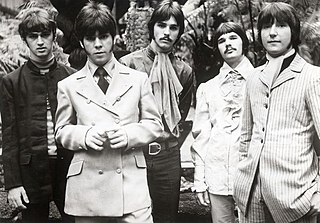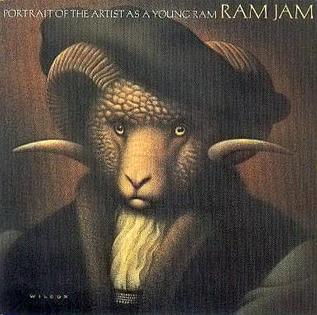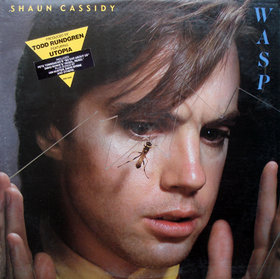Related Research Articles

Joey Levine is an American singer, songwriter and record producer of pop music, who has been active since 1966.
Dance-pop is a subgenre of pop music that originated in the late 1970s to early 1980s. It is generally uptempo music intended for nightclubs with the intention of being danceable but also suitable for contemporary hit radio. Developing from a combination of dance and pop with influences of disco, post-disco and synth-pop, it is generally characterised by strong beats with easy, uncomplicated song structures which are generally more similar to pop music than the more free-form dance genre, with an emphasis on melody as well as catchy tunes. The genre, on the whole, tends to be producer-driven, despite some notable exceptions.
Super K Productions was a 1960s American recording production company under Buddah Records, headed by producers Jerry Kasenetz and Jeffry Katz, whose groups specialized in bubblegum pop. Their biggest successes were The Ohio Express, The 1910 Fruitgum Company, Crazy Elephant and The Music Explosion. Super K also had its own label of the same name in 1969, operated under Buddah Records, but it did not last as the bubblegum genre had already started to decline in popularity.

The Ohio Express is an American bubblegum pop band formed in Mansfield, Ohio, in 1967. Though marketed as a band, it would be more accurate to say that the name "Ohio Express" served as a brand name used by Jerry Kasenetz's and Jeffry Katz's Super K Productions to release the music of a number of different musicians and acts. The best known songs of Ohio Express were actually the work of an assemblage of studio musicians working in New York, including singer/songwriter Joey Levine. Other recorded "Ohio Express" work included material recorded by an early group of Joe Walsh, as well as a later single written and sung by Graham Gouldman.

Buddah Records was an American record label founded in 1967 in New York City. The label was born out of Kama Sutra Records, an MGM Records-distributed label, which remained a key imprint following Buddah's founding. Buddah handled a variety of music genres, including bubblegum pop, folk rock (Melanie), experimental music, and soul.

The Lemon Pipers were a short-lived 1960s American rock band from Oxford, Ohio, United States, known chiefly for their song "Green Tambourine", which reached No. 1 in the United States in 1968. The song has been credited as being the first bubblegum pop chart-topper.

Portrait of the Artist as a Young Ram is the second and final studio album by American rock band Ram Jam, released in 1978. It was re-released in 2006 on Rock Candy Records. The title is a play on James Joyce's semi-autobiographical novel A Portrait of the Artist as a Young Man.

Ram Jam is the debut studio album by American rock band Ram Jam in 1977. The first track on the album, the single "Black Betty", is Ram Jam's best known song. It went to #7 on the UK singles chart in September 1977. The album reached No. 34 on the Billboard Pop Albums chart in the United States. The band was re-christened "American Ram Jam" for the UK market to avoid confusion with a UK band bearing the same name.

"Yummy Yummy Yummy" is a song by Arthur Resnick and Joey Levine, first recorded by Ohio Express in 1968. Their version reached No. 4 on the U.S. Pop Singles chart in June and No. 5 on the UK Singles Chart. It has since been covered by many artists. Ohio Express was a studio concoction and none of the "official" members appear on the record. Joey Levine sang lead vocals.
The Kasenetz-Katz Singing Orchestral Circus was a bubblegum "supergroup" created by record producers Jerry Kasenetz and Jeffry Katz, consisting of various Super K Production groups.

Green Tambourine is the debut studio album by the American rock band the Lemon Pipers. It was released in early 1968 after the band's bubblegum single of the same name had topped the charts in the US.
"Catch a Falling Star" is a song written by Paul Vance and Lee Pockriss. It was made famous by Perry Como who recorded and released his version in late 1957.
Jeffry Katz is an American music producer, one of the first exponents of bubblegum pop.
Jerry Kasenetz is an American bubblegum pop producer who worked with Jeffry Katz, the two working together as the Super K Productions company, to manufacture and produce bands such as Kasenetz-Katz Singing Orchestral Circus, The Music Explosion, 1910 Fruitgum Company, Crazy Elephant, and The Ohio Express.

"Little Bit O' Soul" is a song written in 1964 by British songwriters John Carter and Ken Lewis. It was originally recorded by Coventry band The Little Darlings, and released in 1965 on Fontana Records in the UK.

Wasp is the fifth and final studio album by teen idol Shaun Cassidy, released in 1980. In an attempt to salvage a sinking pop career, Cassidy recruited Todd Rundgren to help "reinvent" his music career. Members of Rundgren's group Utopia also played on the record, and the work had a decidedly "new wave" feel.

Commitment is an album by American singer Bobby Darin, released in 1969. It was released by Darin's own Direction label and did not chart.
"Indian Giver" is a song written by Bobby Bloom, Ritchie Cordell, and Bo Gentry. It was first recorded by 1910 Fruitgum Company for their 1969 album, Indian Giver. Its B-Side, "Pow Wow", was actually a song called "Bring Back Howdy Doody" deliberately pressed backwards as a way of deterring radio stations from playing the B-Side, which was later recorded by another Buddah bubblegum music group produced by Jerry Kasenetz and Jeffry Katz called Flying Giraffe.
Arthur Resnick is an American songwriter, record producer and musician. His most successful songs as a writer include "Under the Boardwalk", "Good Lovin'", and "Yummy Yummy Yummy".

Shadows of Knight is the third studio album by American garage rock band The Shadows of Knight, and was released on Super K Productions, SKS 6002, in 1969. Recording for the album came after lead vocalist Jim Sohns revamped the Shadows of Knight's line-up and signed with Super K. Although Shadows of Knight did not chart and was the last album featuring new material by the group until A Knight to Remember, a single taken from the effort, "Shake", became a moderate national success in the United States.
References
- 1 2 Clarke, Donald (1990). The Penguin Encyclopedia of Popular Music. Penguin Books. p. 173. ISBN 978-0-14-051147-5. Archived from the original on May 1, 2021. Retrieved May 27, 2020.
- 1 2 Perone, James E. (2018). Listen to Pop! Exploring a Musical Genre. ABC-CLIO. p. 56. ISBN 978-1-4408-6377-6. Archived from the original on April 15, 2021. Retrieved May 27, 2020.
- 1 2 3 4 5 6 7 8 9 10 11 12 13 14 15 16 17 Cafarelli, Carl (April 25, 1997). "An Informal History of Bubblegum Music". Goldmine #437. pp. 16–76. Archived from the original on May 15, 2020. Retrieved May 31, 2020.
- 1 2 Cooper & Smay 2001, p. 3.
- 1 2 Ewing, Tom (September 27, 2006). "Edison Lighthouse - "Love Grows Where My Rosemary Goes"". Freaky Trigger. Retrieved November 20, 2022.
- 1 2 3 Carmody, Robin (January 1, 2002). "The Cottage Industry of Moments". Freaky Trigger. p. 1. Retrieved November 20, 2022.
- 1 2 3 Cooper & Smay 2001, p. 271.
- ↑ "Glam Rock". AllMusic . Archived from the original on January 9, 2021. Retrieved May 31, 2020.
- ↑ Cooper & Smay 2001, p. 248.
- ↑ Cooper & Smay 2001, p. 246.
- ↑ "Twee Pop". AllMusic . Archived from the original on March 25, 2017. Retrieved May 31, 2020.
- ↑ Yalcinkaya, Gunseli (March 17, 2021). "Hyperpop is the new sound for a post-pandemic world". Dazed. Archived from the original on April 15, 2021. Retrieved April 17, 2021.
- 1 2 3 4 Cooper & Smay 2001, p. 1.
- ↑ Bubblegum pop music guide
- 1 2 3 4 5 Stanley, Bob (December 2, 2010). "Bubblegum pop: all the young dudes". The Guardian . Archived from the original on October 31, 2020. Retrieved May 27, 2020.
- ↑ "RPM Top 100 Singles - January 20, 1969" (PDF).
- 1 2 n.a. (n.d.). "Pop/Rock » Pop/Rock » Bubblegum". AllMusic . Archived from the original on September 21, 2020. Retrieved May 27, 2020.
- ↑ Cooper & Smay 2001, p. 252.
- ↑ Cooper & Smay 2001, pp. 27, 165, 246.
- ↑ Warner, Jay (2000). The Da Capo Book Of American Singing Groups. Da Capo Press. p. 501. ISBN 978-0306809231.